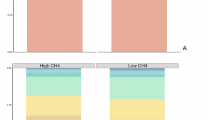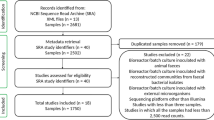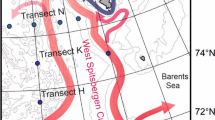Abstract
Intestinal microflora influences many essential metabolic functions, and is receiving increasing attention from the scientific community. However, information on intestinal microbiota, especially for large wild carnivores, is insufficient. In the present study, the bacterial community in the feces of snow leopards (Uncia uncia) was described based on 16S rRNA gene sequence analysis. A total of 339 near-full-length 16S rRNA gene sequences representing 46 non-redundant bacterial phylotypes (operational taxonomical units, OTUs) were identified in fecal samples from four healthy snow leopards. Four different bacterial phyla were identified: Firmicutes (56.5 %), Actinobacteria (17.5 %), Bacteroidetes (13 %), and Proteobacteria (13 %). The phylum Actinobacteria was the most abundant lineage, with 40.4 % of all identified clones, but Clostridiales, with 50 % of all OTUs, was the most diverse bacterial order. The order Clostridiales was affiliated with four families: Clostridiaceae I, Lachnospiraceae, Peptostreptococcaceae, and Ruminococcaceae. Lachnospiraceae was the most diverse family with 17 OTUs identified. These findings were basically consistent with previous reports on the bacterial diversity in feces from other mammals.




Similar content being viewed by others
References
Andersson AF, Lindberg M, Jakobsson H, Bäckhed F, Nyrén P, Engstrand L (2008) Comparative analysis of human gut microbiota by barcoded pyrosequencing. PLoS One 3(7):e2836
Daly K, Stewart CSFHJ, Shirazi-Beechey SP (2001) Bacterial diversity within the equine large intestine as revealed by molecular analysis of cloned 16S rRNA genes. FEMS Microbiol Ecol 38:141–151
Desai AR, Musil KM, Carr AP, Hill JE (2009) Characterization and quantification of feline fecal microbiota using cpn 60 sequence-based methods and investigation of animal-to-animal variation in microbial population structure. Vet Microbiol 137(1):120–128
Eckburg PB, Bik EM, Bernstein CN, Purdom E, Dethlefsen L, Sargent M, Gill SR, Nelson KE, Relman DA (2005) Diversity of the human intestinal microbial flora. Science 308(5728):1635–1638
Frank DN, Amand ALS, Feldman RA, Boedeker EC, Harpaz N, Pace NR (2007a) Molecular-phylogenetic characterization of microbial community imbalances in human inflammatory bowel diseases. Proc Natl Acad Sci USA 104(34):13780–13785
Frank DN, St Amand AL, Feldman RA, Boedeker EC, Harpaz N, Pace NR (2007b) Molecular-phylogenetic characterization of microbial community imbalances in human inflammatory bowel diseases. Proc Natl Acad Sci USA 104(34):13780–13785. doi:10.1073/pnas.0706625104
Garcia-Mazcorro JF, Dowd SE, Poulsen J, Steiner JM, Suchodolski JS (2012) Abundance and short-term temporal variability of fecal microbiota in healthy dogs. Microbiologyopen 1(3):340–347. doi:10.1002/mbo3.36
Good IJ (1953) The population frequencies of species and the estimation of population parameters. Biometrika 40(3–4):237–264
Handl S, Dowd SE, Garcia‐Mazcorro JF, Steiner JM, Suchodolski JS (2011) Massive parallel 16S rRNA gene pyrosequencing reveals highly diverse fecal bacterial and fungal communities in healthy dogs and cats. FEMS Microbiol Ecol 76(2):301–310
Huber T, Faulkner G, Hugenholtz P (2004) Bellerophon: a program to detect chimeric sequences in multiple sequence alignments. Bioinformatics 20(14):2317–2319
Jackson RM (1996) Home range, movements and habitat use of snow leopard (Uncia uncia) in Nepal. University of London, London
Leser TD, Amenuvor JZ, Jensen TK, Lindecrona RH, Boye M, Moller K (2002) Culture-independent analysis of gut bacteria: the pig gastrointestinal tract microbiota revisited. Appl Environ Microbiol 68:673–690
Ley RE, Hamady M, Lozupone C, Turnbaugh PJ, Ramey RR, Bircher JS, Schlegel ML, Tucker TA, Schrenzel MD, Knight R (2008a) Evolution of mammals and their gut microbes. Science 320(5883):1647–1651
Ley RE, Lozupone CA, Hamady M, Knight R, Gordon JI (2008b) Worlds within worlds: evolution of the vertebrate gut microbiota. Nat Rev Microbiol 6(10):776–788
Mentula S, Harmoinen J, Heikkilä M, Westermarck E, Rautio M, Huovinen P, Könönen E (2005) Comparison between cultured small-intestinal and fecal microbiotas in beagle dogs. Appl Environ Microbiol 71(8):4169–4175
Middelbos IS, Boler BMV, Qu A, White BA, Swanson KS, Fahey GC Jr (2010) Phylogenetic characterization of fecal microbial communities of dogs fed diets with or without supplemental dietary fiber using 454 pyrosequencing. PLoS One 5(3):e9768
Rahner R (1901) Bakteriologische mitteilungen ueber die darmbakterien der huehner. Zentralbl Bakteriol Parasitenkd 80:239–244
Ritchie LE, Steiner JM, Suchodolski JS (2008) Assessment of microbial diversity along the feline intestinal tract using 16S rRNA gene analysis. FEMS Microbiol Ecol 66(3):590–598
Ritchie LE, Burke KF, Garcia-Mazcorro JF, Steiner JM, Suchodolski JS (2010) Characterization of fecal microbiota in cats using universal 16S rRNA gene and group-specific primers for Lactobacillus and Bifidobacterium spp. Vet Microbiol 144(1):140–146
Schloss PD, Handelsman J (2005) Introducing DOTUR, a computer program for defining operational taxonomic units and estimating species richness. Appl Environ Microbiol 71(3):1501–1506
Suchodolski JS, Camacho J, Steiner JM (2008) Analysis of bacterial diversity in the canine duodenum, jejunum, ileum, and colon by comparative 16S rRNA gene analysis. FEMS Microbiol Ecol 66(3):567–578
Tamura K, Peterson D, Peterson N, Stecher G, Nei M, Kumar S (2011) MEGA5: molecular evolutionary genetics analysis using maximum likelihood, evolutionary distance, and maximum parsimony methods. Mol Biol Evol 28(10):2731–2739
Tilg H, Kaser A (2011) Gut microbiome, obesity, and metabolic dysfunction. J Clin Invest 121(6):2126
Tun HM, Brar MS, Khin N, Jun L, Hui RK-H, Dowd SE, Leung FC-C (2012) Gene-centric metagenomics analysis of feline intestinal microbiome using 454 junior pyrosequencing. J Microbiol Methods 88(3):369–376
Wang M, Ahrné S, Jeppsson B, Molin G (2005) Comparison of bacterial diversity along the human intestinal tract by direct cloning and sequencing of 16S rRNA genes. FEMS Microbiol Ecol 54(2):219–231
Wu S, Wang G, Angert ER, Wang W, Li W, Zou H (2012) Composition, diversity, and origin of the bacterial community in grass carp intestine. PLoS One 7(2):e30440
Xenoulis PG, Palculict B, Allenspach K, Steiner JM, Van House AM, Suchodolski JS (2008) Molecular‐phylogenetic characterization of microbial communities imbalances in the small intestine of dogs with inflammatory bowel disease. FEMS Microbiol Ecol 66(3):579–589
Zhang H, Chen L (2010) Phylogenetic analysis of 16S rRNA gene sequences reveals distal gut bacterial diversity in wild wolves (Canis lupus). Mol Biol Rep 37(8):4013–4022. doi:10.1007/s11033-010-0060-z
Acknowledgments
The research was supported financially by the following grants: the National Natural Science Fund of China (NO. 31172119), the National Natural Science Fund of China (NO. 31372220), the Natural Science Fund of Shandong Province of China (NO. ZR2011CM009) and the PhD Programs Foundation of Ministry of Education of China (NO, 20113705110001). We are grateful to the Xining Zoo of Qinghai for their great support in sample collecting.
Author information
Authors and Affiliations
Corresponding author
Rights and permissions
About this article
Cite this article
Zhang, H., Liu, G., Chen, L. et al. Composition and diversity of the bacterial community in snow leopard (Uncia uncia) distal gut. Ann Microbiol 65, 703–711 (2015). https://doi.org/10.1007/s13213-014-0909-9
Received:
Accepted:
Published:
Issue Date:
DOI: https://doi.org/10.1007/s13213-014-0909-9




